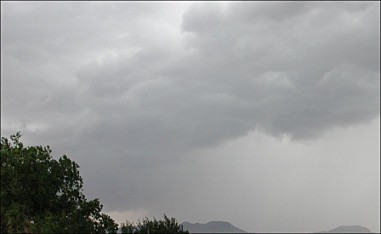

People from damper climates are amazed at the differences between daytime and nighttime temperatures in the desert. The spread often is 25 to 30 degrees or more. One of several factors involved is the amount of greenhouse gases. Almost everyone is aware that carbon dioxide traps heat that otherwise would radiate out into space. Fewer realize that water vapor also is a powerful greenhouse gas, and it's this gas that has such a large effect in the desert—not because there is so much of it, but because there's so little.
Incoming radiation from the sun is barely impeded on its way to the
surface, powerfully heating the barren ground. At night, these same patches of bare
dirt and rock quickly radiate out their captured heat. Whereas in a wetter clime, water
vapor would tend to block the heat's escape into the depths of space, the widely
spaced molecules of desert water vapor allows wholesale liberation. Need evidence?
Consider nighttime temperatures at the height of the monsoon season, when the relative
humidity is high—downright uncomfortably warm!

Contributor: Arthur H. Harris, Laboratory for Environmental Biology, Centennial Museum, University of Texas at El Paso.
Desert Diary is a joint production of the Centennial Museum and KTEP National Public Radio at the University of Texas at El Paso.

Clouds—one indication of the amount of water in the atmosphere.
US Global Change Information Research Office